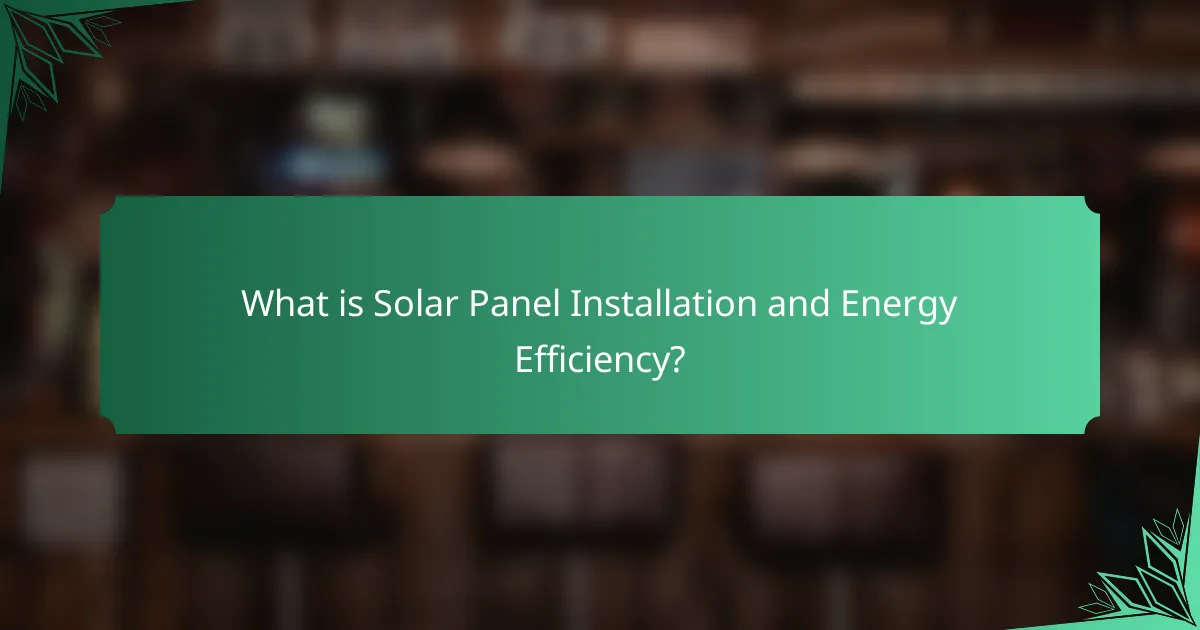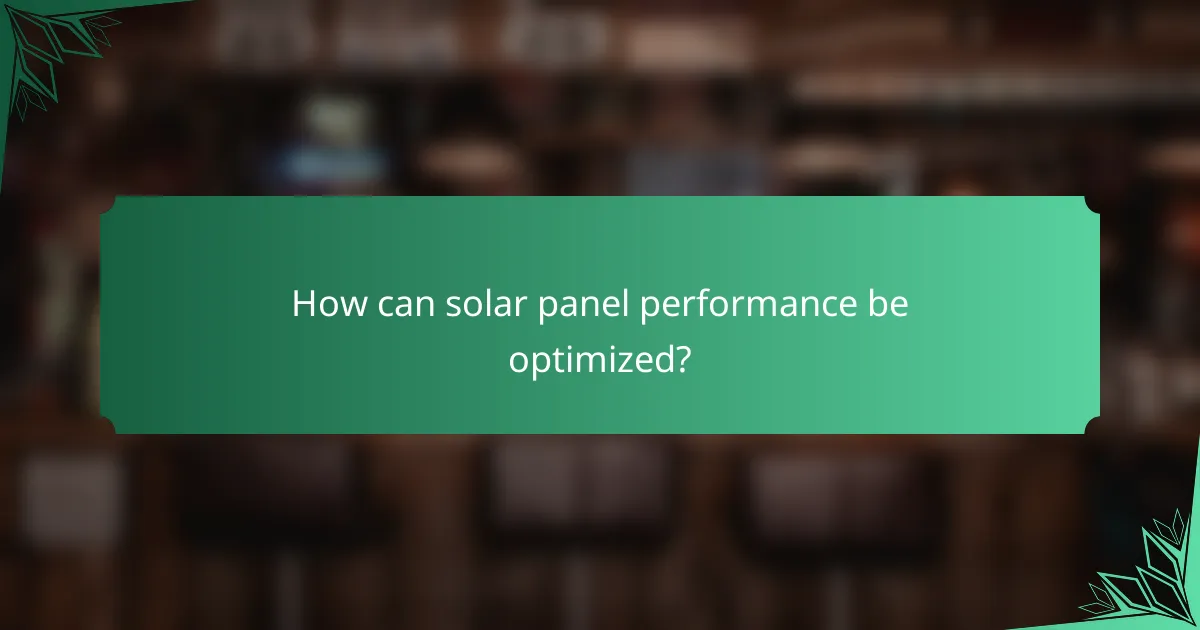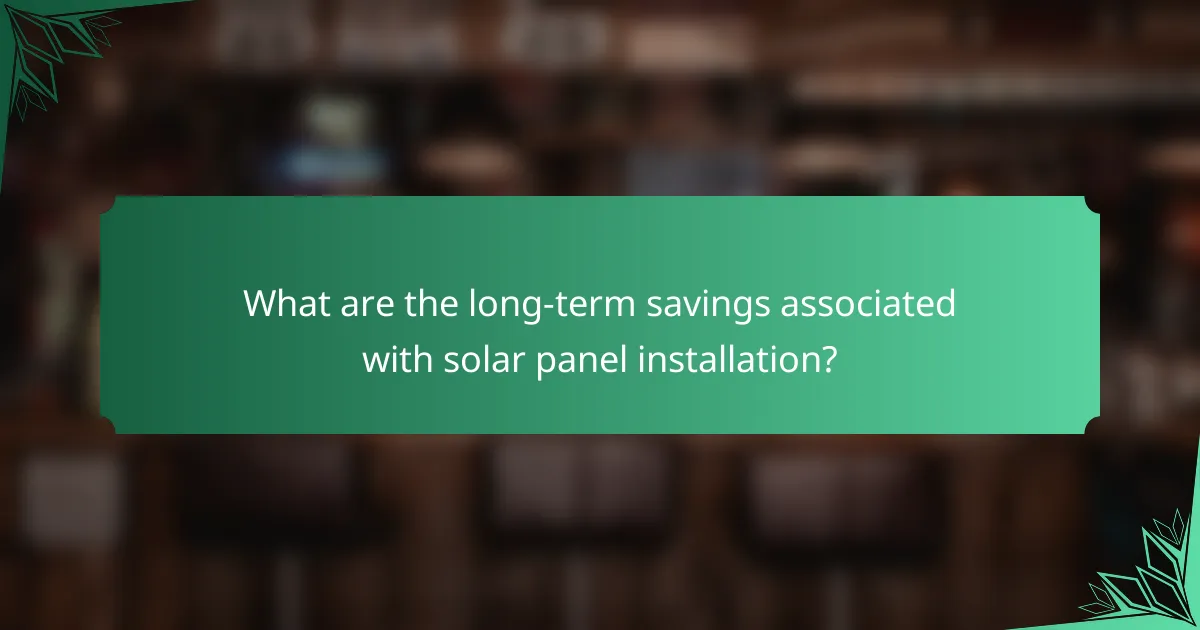
What is Solar Panel Installation and Energy Efficiency?
Solar panel installation refers to the process of setting up solar panels to harness solar energy for electricity generation. This installation includes mounting panels, connecting them to an inverter, and integrating the system with the electrical grid. Energy efficiency involves optimizing energy use to reduce waste and increase productivity. In the context of solar panels, energy efficiency means maximizing the amount of electricity generated relative to the amount of sunlight received. According to the U.S. Department of Energy, solar energy systems can reduce electricity bills by 50-90%. This efficiency contributes to long-term savings and sustainability.
How does solar panel installation contribute to energy efficiency?
Solar panel installation enhances energy efficiency by converting sunlight into usable electricity. This process reduces reliance on fossil fuels, which are less efficient and more polluting. Solar panels typically have an efficiency rating between 15% and 22%, meaning they convert that percentage of sunlight into electricity. By generating clean energy on-site, buildings can lower their energy consumption from the grid. This leads to reduced energy costs over time. According to the U.S. Department of Energy, solar energy can save homeowners an average of $20,000 over 20 years. Additionally, solar panels can increase property value, as energy-efficient homes are often more desirable.
What are the key components of a solar panel installation?
The key components of a solar panel installation include solar panels, inverters, mounting systems, and wiring. Solar panels convert sunlight into electricity. Inverters change the direct current (DC) produced by solar panels into alternating current (AC) for home use. Mounting systems secure the solar panels to rooftops or ground structures. Wiring connects all components and ensures the flow of electricity. Each component plays a crucial role in the efficiency and functionality of the solar energy system. Proper installation of these components can enhance energy production and long-term savings.
How do solar panels convert sunlight into energy?
Solar panels convert sunlight into energy through a process called the photovoltaic effect. When sunlight hits the solar cells, it excites electrons, creating an electric current. This current is then captured and can be used to power electrical devices. Solar panels consist of silicon cells that absorb photons from sunlight. The absorbed energy generates electron-hole pairs in the silicon. These pairs are separated by an electric field within the solar cell. This separation creates a flow of electricity. According to the U.S. Department of Energy, solar panels can convert about 15-20% of sunlight into usable electricity.
Why is energy efficiency important in solar panel systems?
Energy efficiency is crucial in solar panel systems because it maximizes the conversion of sunlight into usable electricity. Higher energy efficiency means more electricity generated per unit of sunlight. This leads to lower energy costs for homeowners and businesses. Efficient systems can significantly reduce reliance on grid electricity. According to the U.S. Department of Energy, high-efficiency solar panels can convert over 22% of sunlight into electricity. This increased output can lead to faster return on investment. Additionally, energy-efficient systems contribute to reduced carbon emissions. This makes them a more sustainable choice for energy production.
What are the environmental benefits of energy-efficient solar panels?
Energy-efficient solar panels reduce greenhouse gas emissions significantly. They generate clean electricity, which decreases reliance on fossil fuels. This transition helps mitigate climate change impacts. Solar panels also conserve water compared to traditional energy sources. For instance, conventional power plants require vast amounts of water for cooling. By using solar energy, water resources are preserved. Additionally, energy-efficient solar panels minimize air pollution. They contribute to improved air quality by reducing pollutants from burning fossil fuels. This results in healthier ecosystems and communities. Studies indicate that widespread solar adoption can lead to substantial reductions in carbon emissions.
How does energy efficiency impact electricity costs?
Energy efficiency significantly reduces electricity costs. By using energy-efficient appliances and technologies, consumers lower their overall energy consumption. This reduction leads to decreased demand for electricity, which can lower utility bills. For instance, ENERGY STAR-rated appliances use 10-50% less energy than standard models. According to the U.S. Department of Energy, energy efficiency improvements can save households an average of $500 annually. Additionally, energy-efficient buildings can reduce energy costs by 30% or more. Overall, increased energy efficiency directly correlates with reduced electricity expenses.

How can solar panel performance be optimized?
Solar panel performance can be optimized through various methods. Regular maintenance, such as cleaning the panels, increases efficiency by removing dirt and debris. Additionally, ensuring proper installation angles maximizes sunlight exposure. Using high-efficiency solar panels can significantly enhance energy output. Monitoring system performance with software helps identify issues promptly. Incorporating energy storage systems allows for better energy management. Upgrading inverters to high-efficiency models can also improve overall performance. These strategies collectively contribute to maximizing the energy harvested from solar panels.
What factors influence the performance of solar panels?
The performance of solar panels is influenced by several key factors. These factors include the angle of installation, which affects sunlight exposure. The orientation of the panels also plays a crucial role in maximizing energy capture. Temperature impacts efficiency; higher temperatures can reduce output. The type of solar panel technology used determines conversion rates. Shading from trees or buildings can significantly decrease performance. Dust and debris accumulation on panels can obstruct sunlight and lower efficiency. Finally, the quality of the inverter affects how effectively the generated energy is converted and utilized.
How does panel orientation affect energy production?
Panel orientation significantly affects energy production in solar systems. Optimal orientation maximizes sunlight exposure throughout the day. South-facing panels in the Northern Hemisphere capture the most sunlight. This positioning increases energy generation by up to 30%. Studies show that panels tilted at an angle equal to the latitude enhance efficiency. Poor orientation can lead to substantial energy loss. For instance, east or west-facing panels produce less energy during peak hours. Adjusting the angle and direction can optimize overall performance.
What role does shading play in solar panel efficiency?
Shading significantly reduces solar panel efficiency. When a solar panel is shaded, its ability to generate electricity decreases. This happens because solar cells work best when they receive direct sunlight. Even partial shading can lead to a substantial drop in output, sometimes by over 50%. The impact varies depending on the extent and duration of the shading. For example, a study by the National Renewable Energy Laboratory found that shading from nearby trees or buildings can lead to energy losses. Therefore, ensuring optimal placement and minimizing shading is crucial for maximizing solar panel performance.
What maintenance practices enhance solar panel performance?
Regular cleaning of solar panels enhances their performance. Dust, dirt, and debris can block sunlight, reducing energy output. Cleaning should occur at least twice a year, or more frequently in dusty areas. Inspecting panels for damage is also crucial. This includes checking for cracks or loose connections. Regular inspections can prevent larger issues that affect efficiency. Monitoring system performance helps identify underperforming panels. A drop in output may signal maintenance needs. Ensuring proper shading is another important practice. Removing nearby obstructions can maximize sunlight exposure. Lastly, professional maintenance checks can provide thorough assessments. Experts can identify issues not visible to the untrained eye.
How often should solar panels be cleaned for optimal performance?
Solar panels should be cleaned at least twice a year for optimal performance. Regular cleaning helps remove dirt, dust, and debris that can obstruct sunlight. This obstruction can reduce energy efficiency significantly. In some regions with heavy rainfall, cleaning may be less frequent. Conversely, areas with high dust or pollution may require more frequent cleaning. Research indicates that dirty panels can lose up to 25% of their efficiency. Therefore, maintaining cleanliness is crucial for maximizing energy production.
What common issues can affect solar panel efficiency?
Common issues that can affect solar panel efficiency include shading, dirt accumulation, temperature extremes, and inverter performance. Shading from trees or buildings can significantly reduce energy production. Dirt and debris on panels can block sunlight, decreasing efficiency by up to 25%. High temperatures can reduce the output of solar panels, with efficiency dropping as temperatures exceed 25 degrees Celsius. Inverter performance is crucial; faulty inverters can lead to significant energy losses. Regular maintenance and monitoring can mitigate these issues, ensuring optimal solar panel performance.

What are the long-term savings associated with solar panel installation?
Long-term savings associated with solar panel installation include reduced electricity bills and potential tax incentives. Homeowners can save an average of $10,000 to $30,000 over 20 years. This estimate varies based on local energy costs and system size. Additionally, many states offer tax credits, rebates, or grants that can further decrease installation costs. Solar panels also increase property value, with homes equipped with solar systems selling for about 4% more. Furthermore, solar energy can protect against rising utility rates, providing stable energy costs over time. According to the National Renewable Energy Laboratory, solar energy can reduce reliance on grid power, leading to significant long-term financial benefits.
How can homeowners calculate potential savings from solar energy?
Homeowners can calculate potential savings from solar energy by assessing their current energy costs and estimating future savings. First, they should determine their average monthly electricity bill. This figure represents their current energy expenditure. Next, homeowners can estimate how much energy their solar system will generate annually. This is usually based on the system size, location, and sunlight exposure.
Homeowners can then multiply the annual energy production by their local electricity rate. This calculation provides an estimate of annual savings. Additionally, they should consider any available tax credits or incentives for solar installation. These can significantly reduce upfront costs and enhance overall savings.
According to the U.S. Department of Energy, homeowners can save an average of $10,000 to $30,000 over 20 years with solar energy. This figure varies based on location and energy consumption patterns. By following these steps, homeowners can effectively calculate their potential savings from solar energy.
What are the average payback periods for solar panel installations?
The average payback period for solar panel installations ranges from 5 to 15 years. This timeframe varies based on factors such as installation costs, energy savings, and local incentives. In many regions, homeowners can expect a payback period closer to 6 to 8 years. According to the National Renewable Energy Laboratory, solar panel systems typically yield a return on investment within this range. Factors like energy prices and state policies can also influence the payback period significantly.
How do government incentives impact long-term savings?
Government incentives significantly enhance long-term savings for consumers. These incentives, such as tax credits and rebates, reduce the initial cost of solar panel installation. Lower upfront costs encourage more homeowners to invest in solar energy. This investment leads to reduced electricity bills over time. According to the Solar Energy Industries Association, homeowners can save an average of $20,000 over 20 years with solar energy. Additionally, government incentives can increase the return on investment for solar systems. This results in quicker payback periods, making solar energy more financially viable. Overall, government incentives play a crucial role in promoting long-term savings through increased adoption of energy-efficient technologies.
What factors contribute to the longevity of solar panels?
The longevity of solar panels is influenced by several key factors. Quality of materials used in manufacturing significantly impacts durability. High-grade silicon and protective coatings enhance resistance to environmental stressors. Installation practices also play a crucial role; proper mounting and orientation optimize performance and reduce wear. Regular maintenance, such as cleaning and inspections, helps identify and mitigate potential issues. Environmental conditions, including temperature fluctuations and exposure to extreme weather, can affect lifespan. Most solar panels are designed to last 25 to 30 years, with warranties reflecting this expected durability. Research from the National Renewable Energy Laboratory indicates that optimal care can extend the functional life of solar panels beyond their warranty period.
How does the quality of installation affect the lifespan of solar panels?
The quality of installation significantly affects the lifespan of solar panels. Proper installation ensures optimal performance and minimizes wear and tear. Poor installation can lead to issues such as water damage, electrical failures, and structural instability. According to the National Renewable Energy Laboratory, well-installed solar panels can last 25 years or more. In contrast, improperly installed panels may fail within a decade. The alignment, secure mounting, and electrical connections are critical for longevity. Studies indicate that up to 80% of solar panel failures stem from installation errors. Therefore, investing in high-quality installation directly correlates with extended panel lifespan.
What warranties are typically offered with solar panel systems?
Solar panel systems typically come with three main types of warranties: product warranty, performance warranty, and installation warranty. The product warranty generally covers defects in materials and workmanship for 10 to 25 years. This warranty ensures that the panels will function as intended without manufacturing flaws.
The performance warranty guarantees a certain level of energy output over time, often for 25 years. This means the solar panels are expected to maintain a specific efficiency percentage, usually around 80% or more after 25 years.
Installation warranties cover the workmanship of the installation process, usually lasting 1 to 10 years. These warranties protect against issues arising from improper installation.
Together, these warranties provide assurance regarding the quality and longevity of solar panel systems.
What best practices can maximize long-term savings from solar panels?
To maximize long-term savings from solar panels, homeowners should focus on proper installation, regular maintenance, and energy efficiency. Proper installation ensures optimal angle and orientation for maximum sunlight exposure. Regular maintenance, such as cleaning panels and checking for damage, can maintain efficiency. Energy-efficient appliances reduce overall electricity consumption, enhancing savings. Monitoring energy production helps identify performance issues early. Utilizing net metering allows homeowners to earn credits for excess energy produced. Investing in high-quality panels with longer warranties can reduce replacement costs. Lastly, staying informed about local incentives can provide financial benefits.
How can homeowners monitor their solar energy production effectively?
Homeowners can monitor their solar energy production effectively by using solar monitoring systems. These systems track energy output in real-time and provide data analytics. Many solar inverters come with built-in monitoring capabilities. Homeowners can access this data through mobile apps or web interfaces. Additionally, external monitoring devices can be installed for more detailed insights. These devices measure performance metrics like energy production and consumption. Studies show that regular monitoring can increase energy savings by up to 20%. By analyzing the data, homeowners can identify performance issues promptly. This proactive approach ensures optimal energy efficiency and maximizes long-term savings.
What common mistakes should be avoided to ensure optimal savings?
Common mistakes to avoid for optimal savings in solar panel installation include inadequate research on system sizing, neglecting local incentives, and improper installation. Inadequate system sizing can lead to insufficient energy production. This often results in higher electricity bills. Neglecting local incentives can mean missing out on significant financial benefits. Many regions offer tax credits or rebates that lower installation costs. Improper installation can cause inefficiencies and reduce the system’s lifespan. Studies show that correctly installed solar panels can produce 20% more energy. Regular maintenance is also essential to avoid performance drops. Ignoring this can lead to increased long-term costs.
Solar panel installation involves setting up solar panels to convert sunlight into electricity, contributing to energy efficiency by reducing reliance on fossil fuels and lowering energy costs. The article explores key components of solar systems, the photovoltaic process, and the importance of energy efficiency in maximizing electricity generation. It also addresses factors influencing solar panel performance, maintenance practices, and common issues that can affect efficiency. Additionally, the article highlights long-term savings associated with solar panel installation, including reduced electricity bills and potential tax incentives, while providing best practices for optimizing performance and ensuring longevity of solar systems.